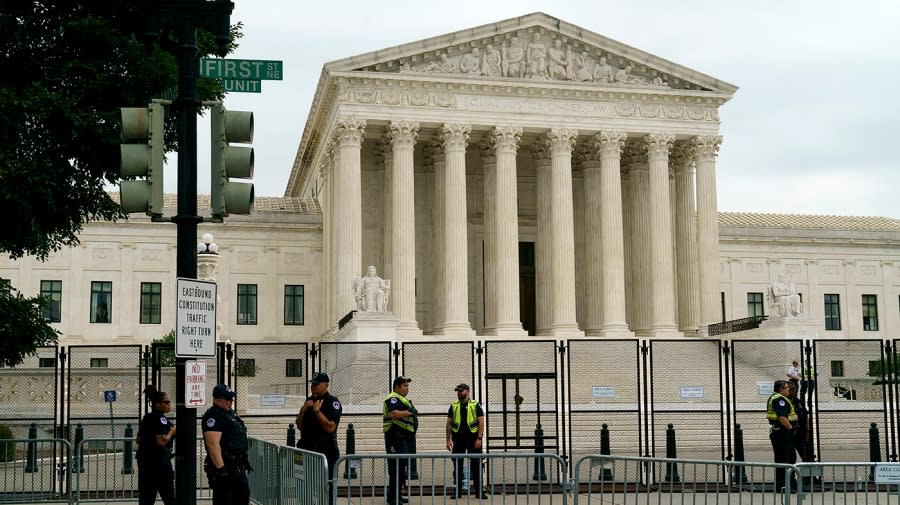Five things to know about the Supreme Court’s ruling on concealed carry

- Oops!Something went wrong.Please try again later.
- Oops!Something went wrong.Please try again later.
- Oops!Something went wrong.Please try again later.
- Oops!Something went wrong.Please try again later.
The Supreme Court on Thursday struck down New York’s law requiring people to demonstrate a special need to carry a concealed handgun outside the home.
The highly anticipated decision could have repercussions beyond New York and stretch into other states that have similar laws, and some legal experts are now casting doubt on the constitutionality of the bipartisan gun safety deal.
Here are five things to know about Thursday’s ruling:
The ruling strikes down New York’s requirement for people to show ‘proper cause’ for concealed carry permits
New York had required individuals to show “proper cause” to obtain a permit for carrying a handgun outside of the home.
Otherwise, they could only receive a “restricted” license to carry in specific circumstances.
Without a statutory definition of “proper cause,” New York courts had set the standard as demonstrating “a special need for self-protection distinguishable from that of the general community.”
That standard often required people to show evidence of threats or attacks to receive a permit.
Six justices on Thursday called that burden inconsistent with Second Amendment protections.
“We know of no other constitutional right that an individual may exercise only after demonstrating to government officers some special need,” Justice Clarence Thomas wrote in his majority opinion.
The ruling is the court’s widest expansion of gun rights in more than a decade
Thursday’s ruling marks the biggest expansion of gun rights since the Supreme Court’s decision in District of Columbia v. Heller in 2008.
In that case, the court ruled that the Second Amendment protects an individual’s right to possess a firearm outside of a militia when using it for traditionally lawful purposes, like self-defense within the home.
The justices noted in Heller that the Second Amendment was “not unlimited” but left the door open to what could be deemed constitutionally permissible restrictions.
Legal experts say Thursday’s ruling overhauls a good portion of previous Second Amendment doctrine.
“The court’s decision today will have major ramifications for gun regulation across the country — effectively making it more difficult for the government to regulate firearms,” said Jared Carter, a constitutional law expert and assistant professor at the Vermont Law School.
The ruling broke along ideological lines
Thursday’s decision split the justices 6-3, with the court’s most conservative justices voting in favor of striking down New York’s law.
Thomas wrote the majority opinion, which was joined by Chief Justice John Roberts and Justices Samuel Alito, Neil Gorsuch, Brett Kavanaugh and Amy Coney Barrett.
Kavanaugh also wrote a concurring opinion, which was joined by Roberts, and Barrett filed a separate concurring opinion.
Meanwhile, Justice Stephen Breyer wrote the dissent, joined by the court’s other two liberals, Justices Sonia Sotomayor and Elana Kagan.
The ruling could affect other states’ concealed carry laws
Most states are known as “shall-issue” states, meaning that applicants who meet legal requirements are automatically granted a permit regardless of their demonstrated need.
Although Thursday’s ruling only directly overruled New York’s law, Thomas noted in his majority opinion that some other states have similar restrictions to the one declared unconstitutional on Thursday.
Thomas explicitly referenced “proper cause” standards, like the one in New York, and laws enacted by California, Hawaii, Maryland, Massachusetts, New Jersey and Washington, D.C.
“In 43 States, the government issues licenses to carry based on objective criteria,” Thomas wrote. “But in six states, including New York, the government further conditions issuance of a license to carry on a citizen’s showing of some additional special need.”
The ruling could cause challenges to the bipartisan gun deal
The court’s ruling comes as the Senate advances a bipartisan gun safety deal that appears poised to pass the upper chamber later this week.
The deal does not include any provisions related to concealed carry permits, but some legal experts are casting doubt on the package’s constitutionality under the legal framework of Thursday’s ruling.
They note how the court ruled that the government must demonstrate gun regulations are “consistent” with the country’s “historical tradition.”
“Only if a firearm regulation is consistent with this nation’s historical tradition may a court conclude that the individual’s conduct falls outside the Second Amendment’s ‘unqualified command,’” Thomas wrote in the majority opinion.
Adam Winkler, a professor at the UCLA School of Law, raised doubts about the court upholding red flag laws, which allow courts to confiscate weapons from someone deemed a danger to themselves or others.
“A law like a red flag law — part of the Senate compromise — is a new modern innovation,” he said. “There is no historical tradition of taking guns away from people who are in crisis.”
He also raised alarm bells about the legislation’s closing of the so-called boyfriend loophole. The legislation would expand existing regulations that prevent abusers in certain circumstances from obtaining a firearm to abusers in romantic and dating relationships.
“Closing the boyfriend loophole is now called into question by this opinion, because there’s no historical regulation of prohibiting boyfriends who engage in domestic violence from possessing firearms,” Winkler said.
For the latest news, weather, sports, and streaming video, head to The Hill.

